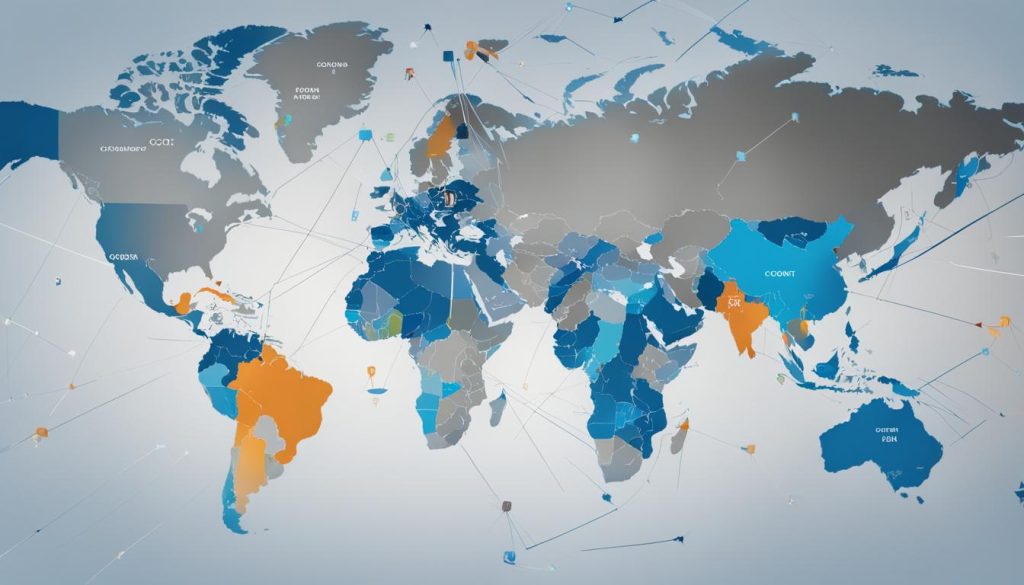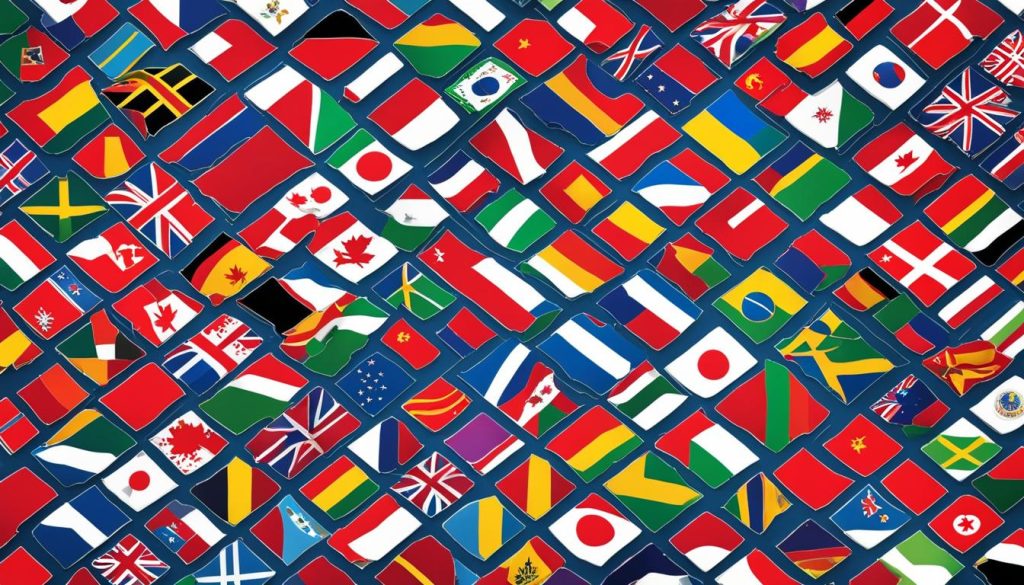Domain Suffixes from the United States and around the World
TLDs, or top-level domains, are an essential part of the internet. They determine the purpose or location of a website and add a distinct identity to web addresses. But did you know that there are over 1,500 TLDs in use worldwide? That’s right! From country code TLDs to generic top-level domains, there is a vast variety to explore. Let’s dive deeper into the world of domain suffixes and discover the fascinating landscape of internet addresses.
Key Takeaways
- Domain suffixes, also known as TLDs, are the last part of a website address.
- There are over 1,500 TLDs in use worldwide.
- TLDs can be categorized into country code TLDs and generic top-level domains.
- Each country has its own unique country code TLD to identify websites affiliated with that country.
- Generic top-level domains are used globally and include popular suffixes like .com, .org, and .net.
What is a Country Code Top-Level Domain (ccTLD)?
A country code top-level domain (ccTLD) is a specific type of TLD that is associated with a particular country or territory. It is identified by a two-letter code, such as .us for the United States or .uk for the United Kingdom. Each country or territory has its own unique ccTLD, which is used to identify websites that are affiliated with that country or territory. ccTLDs are an important part of the Internet’s domain name system and are used to differentiate websites based on their geographical location.
Each ccTLD serves as a digital identifier for a specific country or territory online. It allows users to quickly recognize the origin or affiliation of a website. For example, when you see a website with a .ca domain, you know that it belongs to a Canadian entity. This is especially useful for businesses, organizations, and individuals who want to highlight their connection to a particular country or region.
In addition to geographically indicating website affiliation, ccTLDs offer several benefits. They can help improve search engine optimization (SEO) by targeting specific audiences and increasing website visibility within a particular country or region. Additionally, ccTLDs can instill trust and credibility in users, as they associate the domain with a country’s established regulations and online presence.
Overall, country code top-level domains are an integral part of the Internet’s infrastructure, providing a clear and organized system for identifying websites based on their country or territory of origin.
History of Country Code Top-Level Domains
The history of country code top-level domains (ccTLDs) can be traced back to the mid-1980s. It all began in 1985 when the United States became the first country to register a ccTLD with “.us”. This marked the beginning of a new era in website identification based on geographical locations. Soon after, other countries followed suit, registering their ccTLDs to represent their respective nations.
- In 1986, the United Kingdom registered “.uk” as its ccTLD.
- In 1987, Israel registered “.il” to signify its online presence.
- In 1988, Australia chose “.au” as its ccTLD.
- Canada joined the ranks in 1988 by registering “.ca” as its ccTLD.
As the 1990s began, more countries recognized the importance of ccTLDs and started registering their own. China, for example, registered “.cn” in 1990, while Russia registered “.ru” in 1994. The 1990s saw a significant increase in the number of ccTLD registrations as more countries embraced the internet and the need for distinctive online identities.
Today, there are over 300 ccTLDs registered, with some countries even having multiple ccTLDs to distinguish different regions or purposes. The history of ccTLDs highlights the evolution of the internet and the recognition of the importance of country-specific domains in establishing a unique online presence.
| Year | Country | ccTLD |
|---|---|---|
| 1985 | United States | .us |
| 1986 | United Kingdom | .uk |
| 1987 | Israel | .il |
| 1988 | Australia | .au |
| 1988 | Canada | .ca |
| 1990 | China | .cn |
| 1994 | Russia | .ru |
Delegation and Management of ccTLDs
The delegation and management of country code top-level domains (ccTLDs) play a crucial role in ensuring the smooth functioning of the Internet. The Internet Assigned Numbers Authority (IANA) serves as the central authority responsible for overseeing the delegation and management of ccTLDs.
Under the supervision of IANA, the process of delegation begins with the identification of an appropriate trustee for each ccTLD. The trustee is entrusted with the administrative control and responsibility for the policies and operation of the ccTLD.
It’s important to note that each ccTLD may have its own set of requirements and fees for registering subdomains. Some ccTLDs may require a local presence or connection to the country, while others may have more open registration policies.
Effective management of ccTLDs is essential for maintaining the integrity and reliability of the domain name system. The trustee’s role encompasses enforcing policies, resolving disputes, providing technical support, and ensuring compliance with legal and operational guidelines.
By establishing a clear framework for governance, the delegation and management of ccTLDs enable the Internet to function as a cohesive and interconnected network, facilitating global communication and collaboration.
In the context of ccTLD delegation and management, the establishment of robust policies is paramount. These policies ensure compliance, security, and stability, while also addressing evolving challenges and technological advancements.
To illustrate the process visually, here’s an overview of the delegation and management of ccTLDs:
| Delegation and Management of ccTLDs | Responsibilities |
|---|---|
| Internet Assigned Numbers Authority (IANA) | – Identifying an appropriate trustee for each ccTLD – Delegating administrative control to the trustee – Overseeing policies and operation of ccTLDs |
| Trustee | – Enforcing policies and guidelines – Resolving disputes – Providing technical support – Ensuring compliance with legal and operational requirements |
| ccTLD Registry Operator | – Managing the ccTLD – Overseeing domain name registrations – Ensuring integrity and security |
The delegation and management of ccTLDs are crucial elements that contribute to the overall stability and organization of the Internet. This process ensures that websites associated with specific countries or territories operate efficiently and uphold the necessary policies and regulations.

The Role of Policies in ccTLD Management
Policies play a crucial role in the effective management of ccTLDs. They provide a framework for governing the registration, operation, and use of domain names within each ccTLD.
ccTLD policies establish guidelines regarding eligibility requirements, registration fees, dispute resolution mechanisms, and other aspects that contribute to the seamless functioning and accountability of the ccTLD.
Furthermore, policies help address potential challenges related to trademark infringement, cybersquatting, and other forms of abusive or fraudulent behavior within the ccTLD space.
Ensuring the transparency and consistency of policies is essential in fostering trust and confidence in the ccTLD management process. The continuous review and revision of policies enable adjustments to be made in response to changing legal, technological, and societal landscapes.
By adhering to well-defined policies, ccTLDs contribute to a secure and reliable online environment that promotes legitimate activities and safeguards the interests of domain name holders and end-users alike.
Overview of Country Code Top-Level Domains
Country Code Top-Level Domains (ccTLDs) play a crucial role in the organization and identification of websites based on their geographical location or purpose. As of 2022, there are more than 300 registered ccTLDs, each uniquely associated with a specific country, territory, or region. These ccTLDs are allocated using two-letter codes based on the ISO 3166-1 alpha-2 country codes, providing a standardized system for website classification.
The management and oversight of ccTLDs are the responsibility of registry operators, who are entrusted with the administration of domain name registrations for their respective ccTLDs. Each ccTLD has its own unique DNS name, entity, and registry operator, ensuring that they are distinct and easily identifiable within the internet ecosystem.
It’s important to note that while some ccTLDs have strict registration policies and restrictions, others have more lenient and open registration policies. This ensures that the internet remains inclusive and accessible to individuals and businesses, regardless of their geographical location.
Registry Operators and Management
The registry operator of a ccTLD is responsible for managing and maintaining the ccTLD’s infrastructure, including DNS servers and registration systems. They also establish policies and guidelines for domain name registration within the ccTLD, ensuring that they adhere to local regulations and international standards.
Each registry operator operates under a specific entity, which can be a government entity, a non-profit organization, or a commercial entity. This entity is tasked with the overall stewardship and governance of the ccTLD, ensuring its stability and continuity.
To illustrate the diversity and uniqueness of ccTLDs, here is an example of a registry operator:
| Country Code Top-Level Domain | Registry Operator | Entity |
|---|---|---|
| .ca (Canada) | Canadian Internet Registration Authority (CIRA) | Non-profit organization |

The example above showcases the registration operator for the .ca ccTLD, which is the Canadian Internet Registration Authority (CIRA). CIRA is a non-profit organization dedicated to the management and governance of the .ca ccTLD, ensuring that it remains a trusted and reliable domain extension for Canadian individuals, businesses, and organizations.
In summary, country code top-level domains provide a way to uniquely identify websites based on their geographical location or purpose. These ccTLDs are managed by registry operators, who oversee the registration process and ensure compliance with local regulations. With their distinct DNS names, entities, and registry operators, ccTLDs contribute to the diversity and organization of the internet.
Examples of Country Code Top-Level Domains
Country code top-level domains (ccTLDs) play a vital role in identifying websites associated with specific countries or territories. These unique domain extensions reflect the geographical location of the website and are used by individuals, businesses, and organizations to establish their online presence.
Let’s explore some examples of popular ccTLDs and the countries they represent:
- .ca: Canada – This ccTLD is widely used by Canadian entities to showcase their online presence. It is a trusted domain extension for businesses, organizations, and individuals operating within Canada.
- .uk: United Kingdom – Websites using the .uk domain extension are associated with the United Kingdom. It is commonly chosen by British businesses, educational institutions, and government organizations to signify their presence in the country.
- .au: Australia – The .au domain extension is a popular choice for Australian businesses, universities, and government bodies. It provides a clear indication that the website is related to Australia and is often preferred by local entities.
- .jp: Japan – Websites with the .jp domain extension represent entities based in Japan. It is widely used by Japanese businesses, educational institutions, and government organizations to establish their online identity.
It’s important to note that different ccTLDs may have specific restrictions or requirements for registration. Some ccTLDs may require a local presence or connection to the country, while others have more open registration policies. These policies help ensure that ccTLDs accurately reflect the intended purpose and usage of the domain extension.
The image above visually represents the diverse range of country code top-level domains and their corresponding countries. Each ccTLD plays a crucial role in distinguishing websites based on their geographical association.
Types of Top-Level Domains
Top-level domains (TLDs) play a crucial role in organizing and categorizing websites on the Internet. There are different types of TLDs that serve various purposes and have specific administrative guidelines. Below, I will outline the main types of TLDs:
- Infrastructure TLDs:Infrastructure TLDs are dedicated to specific network infrastructure purposes. One example is the .arpa TLD, which is used for Address and Routing Parameter Area (ARPA) purposes. These TLDs serve essential functions in maintaining the technical operations of the Internet.
- Generic TLDs:Generic TLDs are open for registration by individuals and organizations globally. They are widely recognized and used for a variety of purposes. Examples of generic TLDs include .com, .org, and .net. These TLDs offer versatility and are commonly associated with commercial, non-profit, and network-related websites.
- Sponsored TLDs:Sponsored TLDs are managed by specific organizations or communities that have an interest in a particular industry or cause. These TLDs are often focused on specific communities or professional sectors. One notable example is .museum, which is dedicated to museums and cultural institutions.
- Country Code TLDs:Country code TLDs (ccTLDs) are associated with specific countries or territories. Each country or territory has its own unique ccTLD, identified by a two-letter code. For instance, .ca is the ccTLD for Canada, while .uk is the ccTLD for the United Kingdom. These TLDs help distinguish websites based on their geographical location.
- Test TLDs:Test TLDs are utilized for experimentation and testing purposes. They are not intended for public registration or long-term use. Test TLDs provide developers and enthusiasts with a safe environment to try out new technologies and innovative ideas without affecting mainstream website operations.
Comparison of Top-Level Domain Types
| TLD Type | Purpose | Examples |
|---|---|---|
| Infrastructure TLDs | Specific network infrastructure purposes | .arpa |
| Generic TLDs | Open for global registration | .com, .org, .net |
| Sponsored TLDs | Managed by specific organizations or communities | .museum, .pro, .aero |
| Country Code TLDs | Associated with specific countries or territories | .ca, .uk, .au |
| Test TLDs | For experimentation and testing purposes | .test, .example, .localhost |
Understanding the different types of top-level domains can help individuals and organizations make informed decisions when choosing a suitable domain suffix for their websites. Whether it’s a generic TLD for a global presence or a country code TLD to emphasize local relevance, selecting the right TLD plays a significant role in online identity and branding.
The Evolution of Domain Suffixes
Over the years, the landscape of domain suffixes has undergone significant transformation in tandem with the explosive growth of the Internet and advancements in technology. One notable organization at the forefront of regulating this evolution is the Internet Corporation for Assigned Names and Numbers (ICANN). Acting as the overseer, ICANN ensures the approval process for new top-level domains (TLDs) follows a standardized and meticulous procedure.
As a result of ICANN’s governance, the domain suffix repertoire has expanded, introducing a diverse array of options tailored to specific industries or purposes. Examples of these new domain suffixes include .info, .biz, and .mobi, each catering to different sectors or professional niches. These new TLDs have empowered businesses and individuals by providing more targeted and memorable web addresses.
In addition to the introduction of specialized TLDs, there have been proposals and efforts to embrace internationalized domain names (IDNs). By allowing non-Latin characters in domain suffixes, the Internet can become more inclusive and accessible to different languages, cultures, and communities. As these proposals continue to garner attention and support, we may soon witness a new era of domain suffixes that truly represent the diverse global nature of the Internet.
FAQ
What are domain suffixes?
What is a country code top-level domain (ccTLD)?
What is the history of country code top-level domains?
How are ccTLDs delegated and managed?
What is an overview of country code top-level domains?
Can you provide examples of country code top-level domains?
What are the types of top-level domains?
How have domain suffixes evolved?
- How Strategic SEO Drove Growth for a CPAP E-commerce Brand - July 24, 2025
- Top 3 SEO Companies in Toronto: An Analytical Comparison - July 23, 2025
- SEO for Entry Door Services - April 24, 2025





















Post Comment
You must be logged in to post a comment.